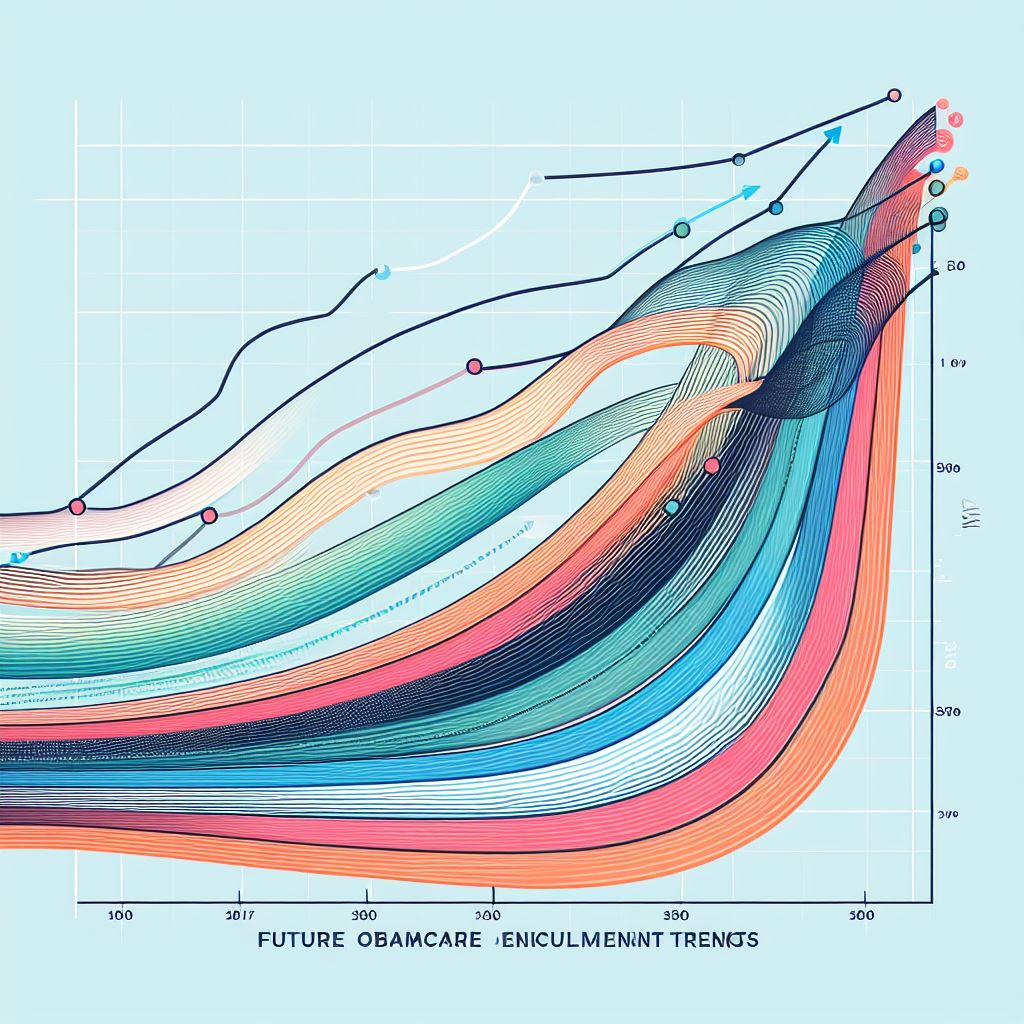5 Best Forecasts for Future Obamacare Enrollment Trends

You won’t believe the five best forecasts for future Obamacare enrollment trends! Get ready to be informed and amazed as we delve into:
- The projected increase in enrollment
- Factors influencing trends
- Potential fluctuations in coverage numbers
- The impact of policy changes
- Emerging patterns
This article will provide you with an analytical and objective analysis of the future of Obamacare enrollment.
So sit back, relax, and prepare to be enlightened!
Key Takeaways
- Significant increase in Obamacare enrollment expected due to the expansion of Medicaid and availability of subsidies and tax credits.
- Fluctuations in coverage numbers likely due to changes in government policies, economic conditions, and individual choices.
- Policy changes, such as modifications to the individual mandate and subsidies, have a significant impact on enrollment numbers.
- Seasonal fluctuations, demographic variations, and geographic disparities in enrollment provide insights for future forecasts and the need for tailored outreach strategies.
Projected Increase in Enrollment
You can expect a significant increase in Obamacare enrollment according to the latest projections. The Affordable Care Act has been instrumental in providing health insurance coverage to millions of Americans who were previously uninsured or underinsured. As more people become aware of the benefits and affordability of Obamacare, enrollment numbers are expected to rise steadily in the coming years.
One of the main factors driving the projected increase in enrollment is the expansion of Medicaid in several states. Under the Affordable Care Act, Medicaid eligibility was expanded to include more low-income individuals and families. This has resulted in a larger pool of potential enrollees who qualify for Medicaid coverage. Additionally, the availability of subsidies and tax credits to help individuals and families afford health insurance premiums has made Obamacare more accessible to a wider range of people.
Another contributing factor to the projected increase in enrollment is the growing awareness and understanding of the individual mandate. The individual mandate requires most Americans to have health insurance or pay a penalty on their taxes. This requirement has prompted many individuals who were previously uninsured to seek coverage through Obamacare.
Factors Influencing Enrollment Trends
Factors driving the projected increase in Obamacare enrollment include the expansion of Medicaid and the individual mandate. The expansion of Medicaid under the Affordable Care Act has allowed more low-income individuals to qualify for health coverage. This has increased the overall number of eligible individuals who can enroll in Obamacare.
Additionally, the individual mandate requires most Americans to have health insurance or pay a penalty. This has incentivized individuals to enroll in Obamacare to avoid the penalty and ensure they’ve access to affordable healthcare.
Other factors that influence enrollment trends include changes in insurance premiums and subsidies. If insurance premiums remain affordable and subsidies are available to help offset the cost, more individuals are likely to enroll in Obamacare. However, if premiums increase significantly or subsidies are reduced, enrollment numbers may be negatively affected.
Furthermore, outreach and education efforts play a crucial role in influencing enrollment trends. Effective communication and marketing campaigns can help raise awareness about the benefits of Obamacare and encourage individuals to enroll. Conversely, a lack of awareness or understanding about the program can hinder enrollment rates.
Potential Fluctuations in Coverage Numbers
Based on the current factors influencing enrollment, fluctuations in coverage numbers under Obamacare are likely to occur. These fluctuations can be attributed to various reasons, such as changes in government policies, shifts in the economy, and individual choices. To provide a visual representation of the potential fluctuations in coverage numbers, the following table outlines some key factors and their impact on enrollment:
| Factors | Impact on Enrollment |
|---|---|
| Government Policies | Changes in subsidy eligibility criteria |
| Alterations in Medicaid expansion | |
| Modifications to individual mandate penalties | |
| Economic Conditions | Unemployment rates affecting affordability |
| Changes in income levels affecting subsidy eligibility | |
| Individual Choices | Consumer preferences for alternative coverage |
| Decision to opt-out due to rising premiums | |
| Changes in life circumstances affecting enrollment |
Government policies play a significant role in determining the eligibility and affordability of coverage, and any changes in these policies can affect enrollment numbers. Economic conditions, such as changes in unemployment rates and income levels, can also impact individuals’ ability to afford coverage and, consequently, their decision to enroll. Additionally, individual choices, influenced by factors like consumer preferences and changes in life circumstances, can lead to fluctuations in coverage numbers.
It is important to note that these fluctuations are not necessarily negative or indicative of a failing system. Rather, they reflect the dynamic nature of Obamacare and the diverse factors that influence individuals’ decisions to enroll.
Impact of Policy Changes on Enrollment
Policy changes have a significant impact on the enrollment numbers of Obamacare. When policies are altered, it can lead to fluctuations in the number of people signing up for coverage. For example, changes in the individual mandate, which required individuals to have insurance or face a penalty, can influence enrollment rates. If the mandate is weakened or eliminated, some individuals may choose not to enroll, resulting in a decrease in overall enrollment numbers. Conversely, if the mandate is strengthened, more individuals may feel compelled to enroll, leading to an increase in enrollment figures.
Other policy changes, such as modifications to subsidies or changes in eligibility criteria, can also affect enrollment. For instance, if subsidies are reduced or eligibility requirements become more stringent, individuals may find it more challenging to afford coverage, resulting in a decline in enrollment. On the other hand, if subsidies are expanded or eligibility criteria are relaxed, more individuals may be able to afford coverage and therefore enroll in Obamacare plans.
Understanding the impact of policy changes on enrollment is crucial for policymakers and stakeholders. By analyzing the potential effects of different policy adjustments, they can better anticipate enrollment trends and make informed decisions to ensure access to affordable healthcare for all Americans.
Transitioning into the subsequent section about emerging patterns in Obamacare enrollment, it’s essential to consider how these patterns may be influenced by both policy changes and external factors.
Emerging Patterns in Obamacare Enrollment
As you analyze the impact of policy changes on Obamacare enrollment, it’s important to consider emerging patterns in enrollment that can provide valuable insights for future forecasts. These patterns can help us understand the behavior of individuals and the factors that influence their decision to enroll in Obamacare.
Here are three key emerging patterns to consider:
- Seasonal Fluctuations: Enrollment in Obamacare tends to follow a seasonal pattern, with higher enrollment during the open enrollment period and lower enrollment outside of this period. This pattern suggests that individuals are more likely to enroll when they’ve a limited time frame to do so, highlighting the importance of effective marketing and outreach efforts during the open enrollment period.
- Demographic Variations: There are noticeable differences in enrollment rates across different demographic groups. For example, young adults have historically had lower enrollment rates compared to older adults. Understanding these demographic variations can help policymakers and healthcare providers tailor their outreach strategies to effectively reach and engage different segments of the population.
- Geographic Disparities: Enrollment rates also vary geographically, with some regions experiencing higher enrollment than others. Factors such as access to healthcare providers, availability of insurance options, and local economic conditions can all influence enrollment rates. Analyzing these geographic disparities can inform targeted efforts to improve enrollment in underperforming regions.
Frequently Asked Questions
How Will Changes in the Economy Impact Future Obamacare Enrollment Trends?
Changes in the economy will impact future Obamacare enrollment trends for you. Factors such as unemployment rates and income levels will influence the number of people signing up for health insurance through the marketplace.
Are There Any Demographic Factors That Will Affect the Projected Increase in Enrollment?
Are there any demographic factors that will affect the projected increase in enrollment? Yes, there are. Factors such as age, income, and location can all play a role in determining who will enroll in Obamacare in the future.
What Role Does Advertising and Marketing Play in Influencing Obamacare Enrollment Numbers?
Advertising and marketing play a crucial role in influencing Obamacare enrollment numbers. By raising awareness, promoting the benefits, and addressing concerns, these strategies can help encourage individuals to enroll in the program.
Are There Any Potential Changes in Government Policies That Could Have a Significant Impact on Obamacare Enrollment?
Potential changes in government policies, such as modifications to subsidies or the individual mandate, could significantly impact Obamacare enrollment. These changes might lead to fluctuations in the number of individuals obtaining coverage through the program.
What Are the Long-Term Implications of Emerging Patterns in Obamacare Enrollment on the Overall Healthcare System?
The long-term implications of emerging patterns in Obamacare enrollment on the overall healthcare system are significant. These patterns can inform policy decisions and shape the future of healthcare access and affordability.



